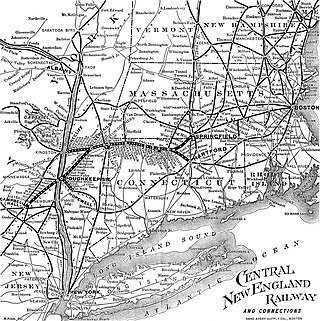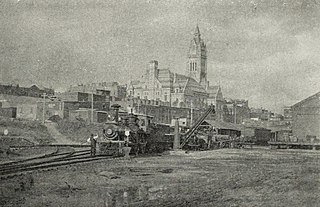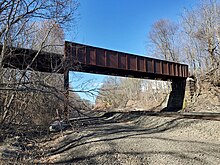
Meriden is a city in New Haven County, Connecticut, United States, located halfway between the regional cities of New Haven and Hartford. The city is part of the South Central Connecticut Planning Region. In 2020, the population of the city was 60,850.

The New York, New Haven and Hartford Railroad, commonly known as The Consolidated, or simply as the New Haven, was a railroad that operated principally in the New England region of the United States from 1872 to December 31, 1968. Founded by the merger of the New York and New Haven and Hartford and New Haven railroads, the company had near-total dominance of railroad traffic in Southern New England for the first half of the 20th century.

The Providence and Worcester Railroad is a Class II railroad operating 612 miles (985 km) of tracks in Rhode Island, Massachusetts, and Connecticut, as well as New York via trackage rights. The company was founded in 1844 to build a railroad between Providence, Rhode Island, and Worcester, Massachusetts, and ran its first trains in 1847. A successful railroad, the P&W subsequently expanded with a branch to East Providence, Rhode Island, and for a time leased two small Massachusetts railroads. Originally a single track, its busy mainline was double-tracked after a fatal 1853 collision in Valley Falls, Rhode Island.

The Central New England Railway was a railroad from Hartford, Connecticut, and Springfield, Massachusetts, west across northern Connecticut and across the Hudson River on the Poughkeepsie Bridge to Maybrook, New York. It was part of the Poughkeepsie Bridge Route, an alliance between railroads for a passenger route from Washington to Boston, and was acquired by the New York, New Haven & Hartford Railroad in 1904.

The New York and New England Railroad (NY&NE) was a railroad connecting southern New York State with Hartford, Connecticut; Providence, Rhode Island; and Boston, Massachusetts. It operated under that name from 1873 to 1893. Prior to 1873 it was known as the Boston, Hartford and Erie Railroad, which had been formed from several smaller railroads that dated back to 1846. After a bankruptcy in 1893, the NY&NE was reorganized and briefly operated as the New England Railroad before being leased to the competing New York, New Haven and Hartford Railroad in 1898.

The Naugatuck Railroad is a common carrier railroad owned by the Railroad Museum of New England and operated on tracks leased from the Connecticut Department of Transportation. The original Naugatuck Railroad was a railroad chartered to operate through south central Connecticut in 1845, with the first section opening for service in 1849. In 1887 the line was leased by the New York, New Haven and Hartford Railroad, and became wholly owned by 1906. At its greatest extent the Naugatuck ran from Bridgeport north to Winsted. Today's Naugatuck Railroad, formed in 1996, runs from Waterbury to the end of track in Torrington, Connecticut. From Waterbury south to the New Haven Line, Metro-North Railroad operates commuter service on the Waterbury Branch.

CT Transit is a public transportation bus system serving many of the metropolitan areas and their surrounding suburbs in state of Connecticut. CT Transit is a division of the Connecticut Department of Transportation, although it contracts a number of private companies for most of its operations. CT Transit began operations in 1976 as Connecticut Transit after the Connecticut DOT's acquisition of the Connecticut Company that year. Although initially serving only the Hartford, New Haven, and Stamford areas, various local companies and private operators became part of the CT Transit system from the 1970s to the early-2000s. CT Transit's service now extends across much of Connecticut, although specifically around the cities of Bristol, Hartford, Meriden, New Britain, New Haven, Stamford, Wallingford and Waterbury. In 2015, CT Transit began operation of CT Fastrak, the first bus rapid transit system in Connecticut and the second in New England.

The Connecticut Company was the primary electric street railway company in the U.S. state of Connecticut, operating both city and rural trolleys and freight service. It was controlled by the New York, New Haven and Hartford Railroad, which also controlled most steam railroads in the state. After 1936, when one of its major leases was dissolved, it continued operating streetcars and, increasingly, buses in certain Connecticut cities until 1976, when its assets were purchased by the state government.

Meriden Transit Center is a train station on the New Haven–Springfield Line located in Meriden, Connecticut. It is served by Amtrak's Northeast Regional, Valley Flyer, and Vermonter, in addition to Hartford Line commuter rail service, consisting of Connecticut Department of Transportation and Amtrak trains. The station was rebuilt from 2014 to 2017 for the Hartford Line service, which began on June 16, 2018.

Berlin station is a train station located in the Kensington neighborhood of Berlin, Connecticut. It is on the New Haven–Springfield Line and is served by Amtrak's Northeast Regional, Hartford Line, and Valley Flyer, in addition to the Hartford Line commuter rail. Two high-level platforms, each six cars long connected by an overhead pedestrian bridge opened at the Hartford Line service launch on June 16, 2018. On December 21, 2016, the historic 1900-built station building was destroyed by a fire.

The Hartford and New Haven Railroad (H&NH), chartered in 1833, was the first railroad built in the state of Connecticut and an important direct predecessor of the New York, New Haven and Hartford Railroad. The company was formed to connect the cities of New Haven, Connecticut, and Springfield, Massachusetts. It built northwards from New Haven, opening its first segment in 1838, and reaching Hartford in December 1839. The company reached Springfield in 1844 under the auspices of the Hartford and Springfield Railroad, a subsidiary chartered in Massachusetts. Branches were later built to Suffield, New Britain, and Middletown and operated by the Hartford and New Haven. The H&NH merged with the New York and New Haven Railroad in 1872, forming the New York, New Haven and Hartford Railroad.

The New Haven and Northampton Railroad was a railroad originally built alongside a canal between 1847 and 1850 in Connecticut. Leased by the New York and New Haven Railroad from 1849 to 1869, the railroad expanded northwards to Massachusetts and its second namesake city in 1859. Upon the end of the lease in 1869, the company expanded further into Massachusetts, reaching as far north as Shelburne and Turners Falls.

Middletown Area Transit, popularly known as MAT, was the provider of public transportation serving Middletown, Connecticut, as well as portions of Cromwell, Durham, East Hampton and Portland. The area routes connect with CTtransit Hartford's 55 route and 9 Town Transit's Route 644 & 645 at the MAT Terminal, including the 590 (M-Link) service connecting with the Meriden Transit District, Amtrak and the Hartford Line at the Meriden railroad station, with CTtransit New Britain's 512 route at Walmart in Cromwell and its 501 route at the Westfield Meriden shopping mall.

Downtown New Britain is a bus rapid transit station and the terminus of the CTfastrak line, located just south of Route 72 off Columbus Boulevard and Main Street in New Britain, Connecticut. It opened with the line on March 28, 2015. The station consists of one side platform and one island platform, comprising a collective total of 19 bus bays for CTfastrak local and express services, plus local CT Transit buses which do not use the busway. The station is located at the site of New Britain's former railroad station, which saw service from 1850 to 1960.

The Boston and New York Air-Line Railroad was a railroad in Connecticut. Envisioned as a direct route between New Haven and Boston, it was hampered by difficult terrain in eastern Connecticut and did not find much success. The New York, New Haven and Hartford Railroad leased the company in 1882. The tracks between Portland, Connecticut and Willimantic, Connecticut were abandoned in 1965, while the remainder of the line is operated by the Providence and Worcester Railroad.

The Connecticut Valley Railroad was a railroad in the state of Connecticut founded in 1868. The company built a line along the Connecticut River between Hartford and Old Saybrook, which opened in 1871. It was reorganized as the Hartford and Connecticut Valley Railroad in 1880, and leased by the New York, New Haven and Hartford Railroad in 1887. Following partial abandonments by the New Haven Railroad and successor Penn Central Transportation Company between 1968 and 1972, the line south of Middletown was revived as the Valley Railroad, a heritage railroad, while the portion in Middletown and northward saw operation by several freight railroads. As of 2022, the Providence and Worcester Railroad and Connecticut Southern Railroad both operate portions of the former Connecticut Valley Railroad.
Connecticut Railway and Lighting Company was a streetcar and bus transit operator serving the region around Bridgeport, Norwalk, Derby, New Britain and Waterbury, Connecticut. It was formed in 1901 by United Gas Improvement Company of Philadelphia to manage the streetcar operations of the Connecticut Light and Power Company, which at the time included Central Railway and Electric Company, Norwalk Street Railway, and the Waterbury Traction Company. The newly formed Connecticut Railway and Lighting acquired Bridgeport Traction Company, Derby Street Railway, Milford Street Railway, Shelton Street Railway, Meriden, Southington and Compounce Tramway Company, and the Cheshire Street Railway. Connecticut Railway and Lighting was leased to the Consolidated Railway and in turn the Connecticut Company between 1906 and 1936. Streetcar operations were discontinued in 1937 when all lines were converted to bus. Transit operations continued until 1972, when all remaining bus operations were suspended and taken over by Connecticut Transit, except in Bridgeport- by the Greater Bridgeport Transit District in 1975.
The Nutmeg train was a unique east-west train through Massachusetts and Connecticut which did not travel along the Atlantic Coast; in the course of following its route it connected several of Connecticut's medium-sized cities. Operated by the New York, New Haven and Hartford Railroad (NH) from 1950, it took a route from Boston's South Station, running through southwestern Boston suburbs but making no stops until Blackstone, Massachusetts, then through northeast Connecticut along the path of the old Southbridge and Blackstone Railroad, divisions of the old New York and New England Railroad to Hartford's Union Station, and finally to Waterbury's Union Station. Running directly through northeastern Connecticut, it made a shorter trip than the itineraries through Springfield, Massachusetts that the New Haven offered.

Cedar Hill Yard is a classification yard located in New Haven, North Haven and Hamden, Connecticut, United States. It was built by the New York, New Haven and Hartford Railroad in the early 1890s in and around New Haven's Cedar Hill neighborhood, which gave the yard its name. Electrical catenary for electric locomotives was added to the yard in 1915. To handle increasing traffic as a result of World War I, the yard was greatly expanded between 1917 and 1920 with additional construction along both sides of the Quinnipiac River. The construction project added two humps where railroad cars were sorted into trains by gravity. The yard was further modernized in the 1920s, becoming one of the busiest railroad yards in the United States, and the most important yard in the entire New Haven Railroad system.






















